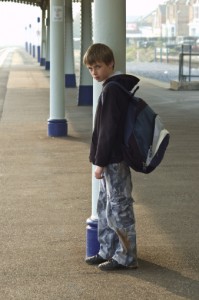Child Abduction: Facts and Strategies
 You probably remember reading about Lenore Skenazy a few years ago. If the name doesn’t ring a bell, she was the mom who let her nine-year-old take a New York City subway home from a department store in the city. She’s also the author of Free Range Kids, a book that touts the benefits of allowing kids to be independent. Her stance was that the dangers of kidnapping and other tragedies that make a mom’s blood run cold are exaggerated.
You probably remember reading about Lenore Skenazy a few years ago. If the name doesn’t ring a bell, she was the mom who let her nine-year-old take a New York City subway home from a department store in the city. She’s also the author of Free Range Kids, a book that touts the benefits of allowing kids to be independent. Her stance was that the dangers of kidnapping and other tragedies that make a mom’s blood run cold are exaggerated.
It can be terrifying to read the statistics: About 800,000 children are reported as missing each year! That’s a lot of children! If you stop reading right there, I wouldn’t blame you one bit for keeping your kids inside the house with you, where they’ll be safe.
But wait… there’s more to the story. Apparently 115 out of those 800,000 missing kids cases actually involve typical stranger-kidnapping, where someone that the child doesn’t know abducts him with the intention of never returning him. The rest of missing children reports encompass family abductions (including when a non-custodial parent takes the child away from the custodial parent), non-family abductions (such as when a friend of the family takes the child) and runaways.
To put it into perspective, the National Weather Service states that there are about 280 reported incidences of people being struck by lightning each year. Your child is more than twice as likely to be struck by lightning than he is to be abducted in the typical “stranger takes your child” scenario that we all envision and have nightmares about.
There are some things that you can do to prevent stranger abduction, of course. They include:
- Teaching kids about typical “child lures.” Let them know that adults don’t ask kids for help in finding a lost puppy or for directions.
- Telling kids what to do if they get lost in a store. Gavin De Becker, author of Protecting the Gift, a book about keeping kids safe, suggests that lost children approach a mother shopping with her children. Another mother is likely to remain with your child until the two of you are reunited, and, statistically speaking, a mom with a child is very unlikely to want to harm or abduct your child.
- Enforcing the “buddy system.” Would-be abductors are more likely to target a child playing alone, and tend to leave groups of kids alone. Insist that if your child is playing outside of your backyard, he stay with a friend.
- Stressing the importance of safety over politeness. If your child feels threatened, he should scream, “no!” and run from the area, without worrying about hurting someone’s feelings.
The possibility that a child may go missing is one that strikes fear into any mom’s heart. With some common sense rules, though, you can safely allow your pre-teens to do things like ride his bike outside of your line of vision, go into a store to buy a candy bar and to play at a neighborhood playground without you. While I would not allow my nine-year-old to navigate the city bus system on her own, it’s important to find the balance necessary to keep kids safe while allowing them some autonomy.
How do you allow independence in your big kids while still keeping them safe?








